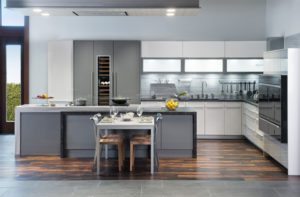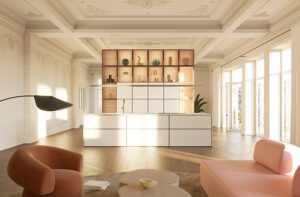A Historic Litchfield County Home with a Modern Sensibility
October 15, 2020
Text by Alyssa Bird Photography by John Gruen Produced by Karin Lidbeck Brent
Finding “The One” can take time. Just ask Jason Puiia, a partner at the Manhattan-based interior design firm Rees Roberts + Partners, and Keith Venkiteswaran, a digital strategist, who looked for a weekend escape in both upstate New York and the Hamptons before a property in Litchfield County finally won them over. “It was unlike anything else we had seen,” says Puiia of the eighteenth-century brick Colonial, one of sixteen recognized historic listings in the village. “I wanted the challenge of working with an older building, and this one had a sense of familiarity about it.”
But dated additions flanking the original 1760 residence were masking its potential, so while it may have been love at first sight for Puiia, Venkiteswaran needed some persuading. “I ended up convincing Keith with a napkin sketch,” recalls Puiia, who had scribbled a renovation plan for the 4,100-square-foot property during a post-showing lunch.
Venkiteswaran got to play client, with Puiia presenting him with sketches, Pinterest boards, and CAD drawings. “I’d spend weeks developing schemes, and then I’d run them by Keith,” says Puiia. His proposal involved gutting the additions—a 500-square-foot rec room that was once a screened-in porch, a former doctor’s office (the previous residents were both physicians), and a 1970s vinyl-clad garage—and better integrating them into the original structure, which the couple wanted to preserve as much as possible.
Opting to tackle the project without an architect, the interior designer consulted with contractors John Considine and Roger Hedman of Riga Construction along the way to ensure that his vision would be buildable and structurally sound. The doctor’s office is now a spacious main-bedroom wing, and the square rec room—with its low ceiling, peeling parquet floor, wood stove, and aluminum sliding doors—became a multipurpose family room complete with a vaulted ceiling, fireplace, workspace, informal dining area, and doors leading out to a new patio. “This is the room we use the most,” says Puiia. “It works just as well for a large group dinner as it does for two people watching a movie.”
The exterior’s most dramatic transformation is the garage, its middle bay replaced with a porte cochere. While one side of the structure still functions as a garage, the other houses storage space and a mudroom that serves as a secondary entrance. “It feels like an old carriage house that could have always been there,” says Puiia, noting the addition of cedar shingles, a cupola, gables, carriage doors, and Belgian block flooring. In fact, the couple’s goal for the entire home was that the renovation not look too new. To that end, Puiia injected architectural elements such as molding, trim, and beadboard that were in keeping with the space’s eighteenth-century origins.
With the shell complete, Puiia could finally get to what he does best. “We took our time furnishing the house, looking for unique pieces at antiques shops and seeking out local artists,” says the designer. “We wanted a comfortable, collected, layered space that felt like it had evolved over time.” And Puiia’s favorite client couldn’t be happier with the result. “Ultimately, we ended up building exactly what Jason drew on that napkin that day,” says Venkiteswaran. “Jason’s superpower is knowing how people want to live.”
Project Team
Interior design: Jason Puiia
Builder: Roger Hedman, John Considine, Riga Construction
[WPSM_COLORBOX id=73546]
Share
![NEH-Logo_Black[1] NEH-Logo_Black[1]](https://www.nehomemag.com/wp-content/uploads/2022/08/NEH-Logo_Black1-300x162.jpg)



















You must be logged in to post a comment.